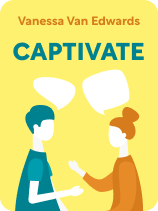

This article is an excerpt from the Shortform book guide to "Captivate" by Vanessa Van Edwards. Shortform has the world's best summaries and analyses of books you should be reading.
Like this article? Sign up for a free trial here.
Do you feel awkward in social situations? Do you know how to have interesting conversations and get people to like you?
In Captivate: The Science of Succeeding With People, best-selling author Vanessa Van Edwards provides strategies to help you become a social superstar. By taking control of social situations and presenting your best self, you can dazzle the people you want to know and forge meaningful relationships.
Keep reading for our overview of this practical and encouraging book, including an exercise that will help you prepare for social success.
Overview of Captivate
A self-proclaimed “recovering awkward person,” Van Edwards has drawn on the research of social psychologists and counselors to develop strategies to make yourself magnetic, bring out the best in other people, and build strong relationships at home and work. A child who made facial flashcards to better understand human emotions, Van Edwards is a TEDx Talk presenter and founder of Science of People, a blog about how to master interpersonal skills.
We present Van Edwards’s tips and strategies from Captivate: The Science of Succeeding With People in two parts:
- Part 1: An examination of how to establish connections with people
- Part 2: An exploration of how to deepen your relationships
Part 1 | Establish Connection: Appeal to Be Appealing
Van Edwards argues that, to get other people to like and remember you, you have to appeal to their sensibilities and the similarities you share. Let’s look at two ways to do that.
Make Social Situations Work for You
Van Edwards says that getting people to like you begins with proactively setting the stage before you meet them.
Step 1: Attend Events Where You’ll Feel Most Confident and Comfortable
Van Edwards recommends making a list of all the settings you love, loathe, and feel okay about, then accept invitations in places you love, reject ones in places you loathe, and take time to consider the ones that are in the locations you feel “okay” in.
Step 2: Position Yourself in the Right Place in the Room
Van Edwards recommends that you interact with people in the places and at the times when they’re most likely to be receptive to conversation. In general, this means approaching people once they’re settled in, not when they’re in transition.
Step 3: Approach Your People, Not All People
Van Edwards argues that you should forge relationships only with people who make you feel good because, when you’re surrounded by people who value and support you, you’re more likely to succeed.
Make Yourself Likable and Memorable
Now you can focus on how to make the most of your first interactions. Let’s look at four ways to do that.
First, Establish Trust and Likability
Van Edwards asserts that people decide whether they trust and like us before we even speak, so it’s critical to make both happen immediately. She says you can increase the likelihood of a positive first interaction by making three simple adjustments to your physical behavior:
- Use your hands to demonstrate that you’re trustworthy. Keep your hands visible to show that you’re not hiding anything, gesture to show your intent, and give a firm handshake, which releases the connection hormone, oxytocin.
- Stand up straight with your shoulders back and chest out to project confidence.
- Maintain eye contact in 60 to 70 percent of your interactions to cultivate trust, demonstrate your interest in the other person, and produce oxytocin.
Be a Curious Conversationalist
Van Edwards recommends grabbing people’s attention and getting them to talk about themselves by initiating unusual conversations and telling stories that are out of the ordinary:
- Initiate thought-provoking conversations. Break out of the boring small talk mold and ignite interesting conversations that push people to think of new and different things. Ask surprising questions, and prompt people to talk about things they’re excited about.
- Tie your story back to the listener. Van Edwards recommends the following three-pronged approach for introducing and using stories to engage and fuel further conversation with people:
- Build off of a frequently discussed subject.
- Tell a funny or quirky story related to that subject.
- End with a transition sentence or question that connects your story back to the person you’re talking with to actively engage them and keep the conversation going.
Be Interested to Be Interesting
Van Edwards asserts that, when you’re genuinely interested in other people, they find you interesting because of the “reciprocity effect,” a phenomenon where we like being with people who clearly like us and we mirror the positive behavior they display toward us.
Van Edwards recommends putting the reciprocity effect into action by interacting with people in ways you’d like them to interact with you. Van Edwards states that engaging people in conversation, encouraging them to talk about themselves, and elevating them by boosting their strong points makes them feel good, which leads them to like and remember you.
As is true with highlighting people’s best qualities, finding your similarities with others makes you more appealing to them. Van Edwards cites research showing that we like and get along more easily with people who agree and share common interests with us.
Be Your Authentic Self
Van Edwards asserts that, when you show your true self by being vulnerable, other people find you more likable, human, and relatable. Van Edwards recommends you show people your vulnerability by asking others for guidance, which lets them know that you don’t have the answers to everything, gives them a chance to share their expertise (which people like), and allows you to learn more about them. She also says you can be vulnerable by apologizing when you’re wrong, asking for forgiveness, and requesting and accepting small favors.
Part 2 | Deepen Your Relationships: Read and Adapt to Your Audience
In Part 1, you learned how to establish connections with people you’ve just met. Now, we’ll examine four of Van Edwards’s methods for getting to know people at a deeper level so you can enhance and improve your relationships.
Method 1: Read Faces to Reveal the Truth
Van Edwards presents and discusses Paul Ekman’s theory of seven universal facial expressions and says that, when you know what they are, you can use them to determine if people are being honest. Van Edwards says that, once you know how to identify the emotion that a microexpression reveals, you should acknowledge it and adjust your behavior to address it. She recommends that you recognize the emotion and try to identify where it’s coming from and respond to the emotion by providing the person with information, support, or solutions.
Method 2: Identify and Play to People’s Key Personality Traits
Van Edwards presents the psychological trait theory that every person has five core personality traits and embodies more or less of each trait:
- Openness: The trait of openness reflects a person’s level of curiosity and creativity, as well as their interest in and willingness to try new things.
- Conscientiousness: The trait of conscientiousness reflects a person’s level of discipline, organization, and reliability in managing tasks. They either prefer focusing on details and organizing or having looser structures and doing big-picture thinking.
- Extroversion: The trait of extroversion reflects a person’s level of interest in engaging with people and the extent to which that engagement fuels or exhausts them.
- Agreeableness: The trait of agreeableness reflects the extent to which a person gets along with, and is able to relate to, others. They’re either more attuned to others’ experiences or more analytical in their approach to them.
- Neuroticism: The trait of neuroticism reflects how a person manages and reacts to concerns and problems. They either worry a lot or don’t easily rattle.
She recommends that you accept people’s traits and adjust your behavior to adapt to them, which will allow you to either work with or around them in challenging situations.
To identify people’s key personality traits, Van Edwards says you can observe and analyze their body language, how they act, and what they say and write.
Method 3: Illuminate and Communicate in People’s Love Language
Van Edwards presents and discusses Dr. Gary Chapman’s five “Love Languages,“ applying them to non-romantic relationships. She says we feel best when others communicate with us in the language we prefer. Knowing people’s love language helps you recognize what makes them feel most appreciated.
The five love languages are:
- Words of affirmation (positive feedback in the form of words)
- Gifts
- Physical touch
- Acts of service (doing things for others)
- Quality time (spending time with people)
Method 4: Identify and Cater to People’s Most Important Value
Van Edwards presents and discusses the work of social psychologist Uriel G. Foa, arguing that each person has six primary resource needs stemming from childhood:
- Love (being accepted)
- Service (being cared for)
- Status (being recognized in a way that makes us feel proud)
- Money (having currency)
- Goods (having material items)
- Information (being taught or guided)
Van Edwards asserts that each of us values and prioritizes one resource need above all others and that this resource drives our behavior. When you know which resource people value most, you can use that to motivate them, make them feel validated, and strengthen your relationship with them.
Exercise: Prepare for Social Success
Van Edwards says that the key to establishing and deepening your relationships with people is proactively setting yourself up for positive interactions, making yourself likable and memorable, and playing to other people’s traits.
- Think of a time you had to go to an event where you didn’t know anyone and you felt uncomfortable and unsure of yourself. What could you do next time to make that event go more smoothly? For example, is there a better location you could choose for striking up a conversation?
- Reflect on a time when you met someone new and felt like your conversation went poorly. What are two things you could do to make that conversation go better next time? For example, could you be a better listener or use an engaging story?
- Think of someone in your life that you wish to understand at a deeper level. How could you use love languages, personality traits, or values to get to know them better?

———End of Preview———
Like what you just read? Read the rest of the world's best book summary and analysis of Vanessa Van Edwards's "Captivate" at Shortform.
Here's what you'll find in our full Captivate summary:
- How socially awkward people can become social superstars
- How to make yourself likable and memorable
- Methods to establish and improve relationships with others






